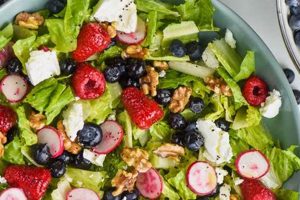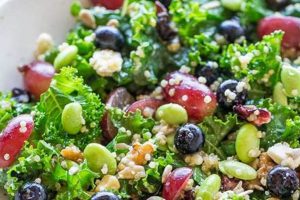A refreshing and nutritious dish, typically composed of cooked lentils, various chopped vegetables, herbs, and a vinaigrette. A simple example combines green lentils, diced cucumber, red onion, bell pepper, parsley, and a lemon-herb dressing. Variations can include other legumes, grains, cheeses, or proteins.
This type of salad offers several advantages. It’s a good source of plant-based protein and fiber, contributing to satiety and digestive health. The versatility of ingredients allows for customization to suit dietary needs and preferences. Furthermore, it’s often prepared ahead of time, making it an ideal choice for meal prepping or potlucks. While its precise origins are difficult to pinpoint, the combination of pulses and vegetables has a long history in numerous cuisines, reflecting both practicality and nutritional wisdom.
The following sections will delve into specific ingredient selections, preparation techniques, dressing options, and creative variations to enhance this culinary staple.
Tips for Preparing a Superior Lentil Salad
Achieving optimal flavor and texture requires attention to detail throughout the preparation process. The following tips offer guidance for creating a truly exceptional dish.
Tip 1: Lentil Selection and Cooking: Opt for small, green or brown lentils that hold their shape well after cooking. Avoid overcooking; lentils should be tender but not mushy. Rinsing after cooking removes excess starch and prevents a gummy texture.
Tip 2: Vegetable Variety and Texture: Incorporate a variety of colorful vegetables with contrasting textures. Diced cucumbers, bell peppers, and carrots provide crunch, while chopped celery and red onion offer a sharper bite.
Tip 3: Herbs and Aromatics: Fresh herbs like parsley, mint, or cilantro add brightness and depth of flavor. Consider incorporating finely minced garlic or shallots for a subtle aromatic touch.
Tip 4: Dressing Considerations: A well-balanced vinaigrette is essential. A classic combination of olive oil, lemon juice, Dijon mustard, and honey provides a tangy and slightly sweet counterpoint to the earthy lentils. Experiment with different vinegar types and seasonings to achieve desired flavor profiles.
Tip 5: Flavor Enhancement through Marinating: Allowing the salad to marinate for at least 30 minutes, or preferably longer, allows the flavors to meld and deepen. This also enhances the texture as the lentils absorb the dressing.
Tip 6: Texture and Temperature Considerations: Serve the salad chilled. The cool temperature enhances the refreshing qualities of the dish and provides a pleasant contrast to the other components. Toasted nuts or seeds can add a welcome textural element.
Tip 7: Ingredient Scalability: The recipe can easily be scaled to accommodate different serving sizes. Adjust ingredient quantities proportionally while maintaining the balance of flavors and textures.
By following these guidelines, one can elevate this simple dish to a culinary masterpiece. Attention to these details results in a more flavorful, visually appealing, and satisfying culinary experience.
These preparation tips lay the foundation for creating a consistently delicious and versatile dish. The following section will explore specific variations and serving suggestions.
1. Ingredient Selection
Ingredient selection is paramount in determining the nutritional value, flavor profile, and overall success of a cold lentil salad. A thoughtful approach to choosing components ensures a balanced and satisfying culinary experience.
- Lentils:
The foundation of the salad lies in the choice of lentils. French green lentils, known for their petite size and ability to hold their shape after cooking, are an excellent choice. Brown or black lentils offer a more robust, earthy flavor. Red lentils, while nutritious, tend to break down during cooking and are less suitable for cold salads.
- Vegetables:
A variety of vegetables contributes textural and flavor complexity. Crisp vegetables like diced cucumbers, bell peppers, and celery offer a refreshing crunch. Chopped red onion adds a pungent bite, while grated carrots provide sweetness and color. Roasted vegetables, such as sweet potatoes or zucchini, can introduce depth and warmth.
- Herbs and Aromatics:
Fresh herbs are essential for brightening the flavor profile. Parsley, mint, cilantro, and dill are popular choices. Finely minced garlic or shallots add a subtle aromatic dimension. Other aromatics, like ginger or chilies, can be incorporated for a more assertive flavor.
- Other Additions:
Beyond the core ingredients, other components can enhance the salad’s flavor and nutritional value. crumbled feta cheese, toasted nuts, dried cranberries, or chopped apples offer textural and flavor contrasts. Cooked quinoa or farro can be added for increased protein and fiber content.
The interplay of these ingredients determines the final character of the cold lentil salad. Careful consideration of each element, from the type of lentil to the accompanying vegetables, herbs, and additions, results in a well-balanced and flavorful dish.
2. Texture
Texture plays a crucial role in the overall enjoyment of a cold lentil salad. A successful recipe balances contrasting textures, creating a dynamic and satisfying sensory experience. The interplay of textures contributes significantly to the dish’s appeal, preventing monotony and enhancing the individual flavors of the components. A variety of textural elements elevates the salad from simple sustenance to a more engaging culinary creation.
Consider the foundational element: cooked lentils. Properly cooked lentils offer a slightly firm, yet tender texture. Overcooked lentils become mushy, resulting in a less appealing, homogenous consistency. This textural foundation provides a backdrop against which other ingredients contribute contrasting sensations. Crisp vegetables, such as diced cucumbers, bell peppers, and celery, introduce a refreshing crunch. Toasted nuts or seeds, like slivered almonds or pumpkin seeds, offer a satisfying chewiness. Crumbled feta cheese provides a creamy counterpoint. Even the dressing contributes to the textural experience; a vinaigrette adds a subtle slickness that coats the other ingredients without making them soggy. The absence of textural variation can result in a bland and less satisfying dish, highlighting the critical role this element plays in the overall culinary experience.
Achieving optimal textural balance requires careful consideration of ingredient selection and preparation methods. Choosing lentils that hold their shape well during cooking is essential. Precise cooking times prevent overcooking and maintain the desired firmness. Incorporating a variety of vegetables with diverse texturesfrom crunchy to slightly softadds complexity. Finally, adding elements like toasted nuts or crumbled cheese provides additional textural layers, elevating the dish to a more sophisticated and enjoyable culinary experience. Understanding and manipulating these textural nuances is key to crafting a successful and satisfying cold lentil salad.
3. Flavor Balance
Flavor balance is essential to a successful cold lentil salad recipe. The inherent earthiness of lentils necessitates the inclusion of ingredients that provide contrasting and complementary flavors. Without this balance, the salad can be monotonous and lack depth. A well-balanced salad engages the palate with a complex interplay of tastes, creating a more satisfying and enjoyable culinary experience.
This balance is typically achieved through the strategic combination of several flavor profiles. The earthiness of lentils provides a grounding element, upon which brighter, more assertive flavors can build. Acidity, from ingredients like lemon juice or vinegar in the vinaigrette, cuts through the richness of the lentils and adds a refreshing tang. Sweetness, often incorporated through chopped fruits like apples or dried cranberries, or a touch of honey in the dressing, offers a contrasting element that prevents the salad from becoming too tart. Fresh herbs, such as parsley, mint, or cilantro, contribute herbaceous notes and a vibrant freshness. The addition of salty elements, like feta cheese or olives, further enhances the complexity of the flavor profile, amplifying the other tastes and creating a more well-rounded experience. For example, a salad with lentils, chopped cucumbers, red onion, feta cheese, and a lemon-herb vinaigrette demonstrates this balance: the earthiness of the lentils is complemented by the cool cucumber, pungent red onion, salty feta, and bright vinaigrette.
Understanding the interplay of these flavors allows for customization and creativity within the basic framework of a cold lentil salad recipe. Adjusting the proportions of acidic, sweet, salty, and herbaceous elements allows one to tailor the salad to specific preferences. Furthermore, recognizing the importance of flavor balance enables the substitution of ingredients while maintaining a harmonious overall taste. A chef, for instance, might substitute lime juice for lemon juice and add diced mango instead of apples, retaining the desired balance of acidity and sweetness while introducing new flavor dimensions. This knowledge empowers culinary exploration and ensures a consistently delicious and well-balanced final product.
4. Dressing Choice
Dressing choice significantly impacts the overall flavor profile and enjoyment of a cold lentil salad. The dressing not only adds moisture and binds the ingredients together but also contributes essential flavor components that complement and enhance the other elements of the salad. A carefully selected dressing elevates the dish from a simple combination of ingredients to a cohesive and flavorful culinary experience.
- Acidity:
Acidity is a crucial element in lentil salad dressings. It provides brightness and cuts through the earthiness of the lentils. Common sources of acidity include lemon juice, vinegar (red wine, white wine, balsamic), or even citrus zest. The level of acidity should be balanced to complement, not overpower, the other flavors. For instance, a light and tangy lemon vinaigrette pairs well with a salad featuring fresh herbs and vegetables, while a richer balsamic vinaigrette might complement a salad with roasted vegetables and stronger cheeses. The choice of acid significantly influences the final taste profile.
- Oil:
The oil component of the dressing contributes richness, mouthfeel, and flavor. Extra virgin olive oil is a classic choice, offering a fruity and peppery flavor. Other oils, such as avocado oil or grapeseed oil, provide a more neutral flavor profile, allowing other ingredients to shine. The ratio of oil to acid in the dressing affects the texture and emulsification, and the choice of oil impacts the overall flavor profile.
- Sweetness:
A touch of sweetness can balance the acidity and add complexity to the dressing. Honey, maple syrup, or a small amount of sugar are common sweeteners. This sweetness complements the earthiness of the lentils and other vegetables. However, the amount of sweetener should be judiciously used to avoid overpowering the other flavors. For example, a vinaigrette with a touch of honey pairs well with roasted vegetables and nuts, adding a subtle sweetness that balances the savory elements.
- Seasoning and Aromatics:
Seasoning is vital in any dressing. Salt and freshly ground black pepper are fundamental. Additional seasonings, like Dijon mustard, garlic, shallots, or herbs, add depth and complexity. The choice of seasonings should complement the overall flavor profile of the salad. For instance, a Dijon mustard vinaigrette with fresh herbs complements a salad with green lentils and fresh vegetables, while a dressing with cumin and chili powder might be more appropriate for a Southwestern-inspired lentil salad.
These facets of dressing choice work in concert to create a harmonious balance of flavors that enhances the overall enjoyment of the cold lentil salad. Choosing a dressing that complements the other ingredients is essential. The right dressing elevates the dish from a simple combination of ingredients to a well-rounded and flavorful culinary experience. The interplay of acidity, oil, sweetness, and seasonings determines the final character of the dressing and its impact on the lentil salad, underscoring the importance of thoughtful dressing selection.
5. Preparation Method
Preparation method significantly influences the final quality and enjoyment of a cold lentil salad. Proper techniques ensure optimal texture, flavor development, and food safety. Overlooking key steps can result in a mushy, bland, or even unsafe dish. The method encompasses several crucial stages, each contributing to the overall success of the recipe.
Lentil cooking is paramount. Lentils should be cooked until tender but not mushy, retaining their shape and texture. Rinsing cooked lentils removes excess starch, preventing a gummy consistency. Vegetable preparation is equally important. Uniformly dicing vegetables ensures even cooking and distribution of flavors throughout the salad. Furthermore, incorporating a variety of vegetables with contrasting textures adds complexity and visual appeal. For example, combining crisp cucumbers, bell peppers, and red onion with softer cooked lentils creates a balanced textural experience. Dressing preparation and incorporation is another crucial step. A properly emulsified vinaigrette distributes flavor evenly and coats the salad components without making them soggy. Allowing the salad to marinate for a period allows the flavors to meld, resulting in a more cohesive and flavorful dish. For instance, marinating the salad for at least 30 minutes allows the lentils to absorb the dressing and the flavors to deepen.
Mastering the preparation method ensures a consistently delicious and satisfying cold lentil salad. Attention to detail at each stage, from lentil cooking to ingredient preparation and dressing incorporation, results in a superior culinary outcome. Understanding the cause-and-effect relationship between preparation techniques and the final product allows for informed adjustments and creative variations while maintaining the core principles of a well-executed cold lentil salad. This understanding not only improves the immediate culinary result but also fosters confidence and creativity in the kitchen, empowering individuals to adapt and personalize recipes to their liking. Failure to adhere to proper preparation methods can lead to textural inconsistencies, flavor imbalances, and potential food safety issues, highlighting the practical significance of mastering these techniques.
6. Presentation
Presentation plays a significant role in the overall perception and enjoyment of a cold lentil salad. While flavor and texture are paramount, visual appeal enhances the dining experience. A thoughtfully presented salad is more enticing and appetizing, elevating a simple dish to a more refined culinary offering. Presentation encompasses various elements, including plating, garnishing, and the overall arrangement of the salad components.
Consider the impact of color. A vibrant and colorful salad is naturally more appealing. Incorporating a variety of colorful vegetables, such as red bell peppers, green cucumbers, orange carrots, and deep purple red onion, creates visual interest. Fresh herbs, like bright green parsley or deep green cilantro, further enhance the visual appeal. The choice of serving dish also contributes to the presentation. A white or light-colored bowl or platter provides a neutral backdrop that allows the colors of the salad to stand out. The arrangement of ingredients influences perception. Rather than simply tossing all ingredients together, consider layering them or arranging them in distinct sections on the plate. This creates visual contrast and allows individual components to be appreciated. Garnishes add a final touch of elegance. A sprinkle of toasted nuts, crumbled cheese, or a scattering of fresh herb sprigs elevates the presentation and adds textural and flavor accents. A simple garnish can transform a basic salad into a visually stunning dish.
Thoughtful presentation enhances the perceived value and enjoyment of a cold lentil salad. While a delicious salad will be enjoyed regardless of its presentation, taking the extra time to consider visual elements elevates the dining experience. The interplay of colors, textures, and the overall arrangement transforms a simple dish into a more appealing and satisfying culinary creation. Furthermore, careful presentation demonstrates attention to detail and care in preparation, enhancing the perceived quality of the meal. This understanding of presentation’s impact allows for the creation of dishes that are not only delicious but also visually appealing, maximizing the overall enjoyment of the culinary experience.
Frequently Asked Questions
This section addresses common inquiries regarding cold lentil salad preparation and provides concise, informative responses.
Question 1: What type of lentil is best suited for cold lentil salad?
French green lentils or Le Puy lentils are ideal due to their ability to hold their shape after cooking and their firm texture. Brown or black lentils can also be used, offering a more robust flavor.
Question 2: Can cold lentil salad be prepared in advance?
Yes, it is well-suited for advance preparation. In fact, the flavors often meld and improve after a period of refrigeration, making it an excellent choice for meal prepping or potlucks. Ideally, prepare the salad at least a few hours before serving, or even the day before.
Question 3: How long does cold lentil salad last in the refrigerator?
Properly stored in an airtight container, it typically lasts for 3-5 days in the refrigerator.
Question 4: How can one prevent the salad from becoming mushy?
Avoid overcooking the lentils; they should be tender but not mushy. Rinsing the lentils after cooking helps remove excess starch, further preventing a gummy texture. Adding the dressing just before serving, or only to the portion being consumed, can also help maintain the desired texture.
Question 5: What are some suitable dressing alternatives to a vinaigrette?
While vinaigrettes are classic, a lemon-tahini dressing, a yogurt-based dressing, or even a pesto-based dressing can provide interesting flavor variations. The key is to select a dressing that complements the other ingredients and balances the earthiness of the lentils.
Question 6: How can nutritional value be maximized?
Incorporating a variety of colorful vegetables increases vitamin and mineral content. Adding other ingredients such as chopped nuts, seeds, or dried fruits enhances nutritional density with healthy fats, fiber, and antioxidants.
Addressing these common questions provides a foundation for successful preparation and enjoyment. Understanding these key aspects ensures a consistently delicious and satisfying culinary experience.
This concludes the frequently asked questions section. The following section will offer concluding thoughts and recipe variations.
Conclusion
Exploration of this culinary staple reveals a dish offering both versatility and nutritional value. Careful ingredient selection, attention to texture and flavor balance, and proper preparation techniques are essential for optimal results. From the choice of lentils and vegetables to the dressing and presentation, each element contributes to the final product. Understanding these components allows for informed customization and adaptation to individual preferences and dietary needs. This adaptable dish can accommodate a wide range of flavors and ingredients, highlighting its potential as a culinary canvas.
This exploration encourages culinary experimentation and appreciation for the nuanced interplay of flavors and textures within a seemingly simple dish. Continued exploration of global culinary traditions reveals further potential for variation and innovation, enriching culinary experiences and promoting healthful eating habits. One can anticipate continued evolution of interpretations, reflecting ongoing culinary innovation and evolving dietary preferences.






